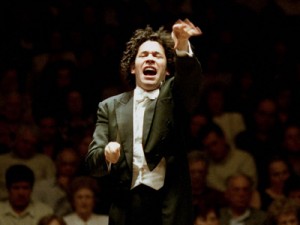
L.A. Philharmonic’s broadcast suggests: Why not here?
This past Sunday, I headed out to a local movie theater to catch a live broadcast of the Los Angeles Philharmonic, in an all-Brahms afternoon under conductor Gustavo Dudamel. There was a sizable crowd in the theater (in southern Palm Beach County), and they seemed to really enjoy the concert, which was well presented by actor John Lithgow. Soloists in the Brahms Double Concerto were the French siblings Renaud (violin) and Gautier (cello) Capucon, and in that piece and the Brahms Fourth Symphony, the L.A. Philharmonic played with bigness and warmth.
Dudamel is much-vaunted for his energetic interpretations, and there was a good bit of that. Overall, however, I found his readings quite conservative, and at some points, particularly in the finale of the Fourth, he seemed to linger over the sounds his orchestra was making, which cost the music some forward motion. But soloists, conductor and orchestra all did a fine job, and the presentation — the third and last in the L.A. Philharmonic’s inaugural season of HD simulcasts — went off without a hitch. Lithgow was especially charming, and he helped give the effort a homey, comfortable feel that was most engaging.
Earlier in the week, I talked to Chris Ayzoukian of the L.A. Philharmonic and Dan Diamond of NCM Fathom, the theater chain that presents these broadcasts, as well as the very popular Metropolitan Opera live broadcasts. Both men said much the same thing (as did Lithgow) about one of the goals of these concerts: To get a local audience to support its own orchestras and other arts groups.
One of Ayzoukian’s sisters proves the point. Not a classical music fan, she went to one of the broadcasts and found herself intrigued. “Now she says she’s going to go to the concert hall next time,” he said.
Ayzoukian, the orchestra’s director of recorded media and special projects, said the broadcasts are an “in-between experience, between home and concert hall. We want to see if we can encourage audiences to go and support their local symphony and see the value in these kinds of experiences.”
Diamond, vice president of Centennial, Colo.-based NCM Fathom, said Dudamel himself, a graduate of Venezuela’s remarkable El Sistema music education program, is an example of how arts outreach can change lives.
“The orchestra encourages the fans to attend the concerts of their local symphony and get involved in the arts,” Diamond said. “It does outreach in Southern California, and it wants to spread that across the country.”
Over on 17th Street in Miami Beach, the New World Symphony makes a good outreach effort in its wallcasts on the great white expanse of its Gehry-designed New World Center (the architect also designed the Disney Concert Hall from which the L.A. Philharmonic concert emanated). Its desire to seduce casual foot traffic into a concert experience is a good one.
But is there a chance for the New World Symphony, the Miami Symphony Orchestra, perhaps Seraphic Fire or the Master Chorale of South Florida, the Cleveland Orchestra at the Knight Concert Hall or one of the good chamber music series, such as the Sunday Afternoons of Music, to reach out digitally to a wider audience? No one would tell me how much the L.A. Philharmonic spent on these broadcasts, but it’s clear it’s trying to make sure the L.A. Philharmonic becomes more of a national brand than it is now, and it thinks it has, in Dudamel, the ideal emissary for that message.
Although the L.A. Philharmonic is the first orchestra to try this nationwide, the Philadelphia Orchestra has broadcast some of its concerts over the private SpectiCast network in that city’s region since June 2009. And it’s perhaps that approach that would be most ideal for our arts organizations. The technology certainly exists, and while the money would initially be a hurdle, it seems to me this would be an ideal time for our area’s classical music groups to present its best work on a regularly available video channel and show it in theaters, as well as over the Internet.
Los Angeles will always be associated with the film industry in the popular mind, but the California city has a long history of good classical music as well. These broadcasts only help widen the country’s knowledge of what that city has to offer. If we don’t yet have an orchestra of the caliber of the L.A. Philharmonic (full disclosure: I went to high school with one of the orchestra’s members), we do have a lot of first-rate music-making hereabouts, and I for one think it would be exciting to see, among the movie listings, the occasional broadcast from the New World, the Miami Symphony Orchestra or the Knight. I don’t see a national broadcast series yet, but perhaps over time.
Culture is what makes an economy really flourish, and aside from the culture that arises naturally from our diverse mix of peoples, we’ve got a substantial amount of standard high culture here. A modest movie broadcast series could be a good way to show the rest of the region all about it.
Recent Content
-
Artsarticle ·
-
Artsarticle ·
-
Artsarticle ·
